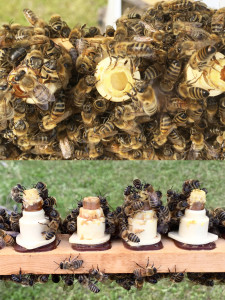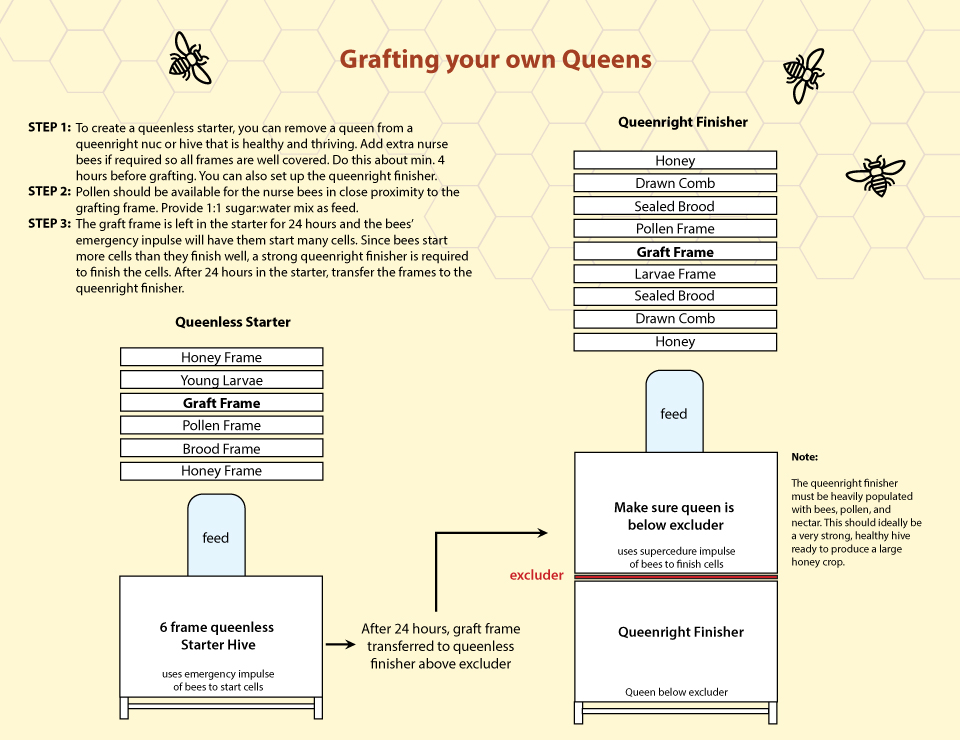Starting and Finishing Queen Cells
Starting and Finishing Queen Cells
The starter/finisher method of queen rearing and cell building uses the natural instincts of the bees. The queenless starter uses the emergency mode to start lots of cells and then the queenright finisher uses the supercedure impulse of the bees to finish the cells. We will discuss the roles each hive plays in the development of quality queen cells.
The Starter
The chart below is one that I designed and is a method for producing 30 quality queen cells. It uses some of the industry’s most common techniques and uses a queenless starter for 24 hours and then a queenright finisher to finish off the cells. Starters are not good at finishing cells and therefore a finisher must be used.

The starter should have lots of nurse bees and should be able to start many cells. Thousands of nurse bees will visit each cell every day feeding the young larvae. Cells with lots of royal jelly inside the cups are desirable. Those will become your most productive, best looking queens.
You can leave the cells in the starter between 24-48 hours and when you take them out, there should be plenty of royal jelly inside the cups. The larvae should have lots of food while it’s developing.
The Finisher
The cell finisher should have the following:
- A queen in the bottom box and a queen excluder.
- It must be a well fed colony.
- Empty drawn comb and sealed brood in bottom box.
- Unsealed brood, pollen and honey in upper box.
- Feeding must be done 3 days prior and during the cell finishing process.
When transferring the cells to the finisher, use a smoker to get bees off the cells. Do not use a brush because the cells are fragile and you could easily damage them. Plenty of smoke will cause bees to fly off. You can then put the graft frame into the finisher when most of the bees are off. Don’t worry about damaging or dislodging the larve. They stick well to the royal jelly and surface tension keeps them in place. We still handle them with care and have never had any issues.
When queen cells are sealed, you can either keep them in the finisher until you put them into a mating box or nuc. If you are planning on another round of grafts, an incubator set at 33.5 Celcius has yielded excellent results for us. This keeps a steady temperature and when it’s time to place them into a mating nuc or nuc, you can take them quickly install them. An uncubator is our preference.
Conclusion
If you follow these steps, you should get good quality queen cells. Not all cells are great and you can discard them. Overall, the quality of the queens you will get if they are mated properlly is easily the same and better of commercially produced stock.
Note: You cannot use the images above without permission.

January 25, 2019 @ 12:26 pm
Just some comments, not as critiscism but to have maybe some relevant answer from you. I’m on the way to optimize my queen rearing (low scale, between 10 and 20 just enough to survive)
I think there is a misunderstanding of what is a starter and a finisher.
The couple starter-finisher is justified only to produce several series of queen cells (Hundreds!). The move from starter to finisher is only to save time and produce more. The starter alone cannot produce many series in the same time.
The conclusion is that we don’t need a starter, we don’t need a finisher, but only an true orphan colony (no queen, no brood, no larvaes, no queen cells) with a lot of young bees and enough food.
Then you introduce the grafted frame (20 queen cells!) and you wait for 10 days. That’s it. No?
Well, if you have any remark, don’t hesitate.
Best from France (Nyons)
January 26, 2019 @ 11:05 am
You are correct, if you are only looking to do a few cells, then you don’t need this method. I can leave everything in a hive with the conditions you mentioned and that works also for a small number of cells. However, the criteria you suggested are optimum for creating good cells, but is often not the reality in a regular hive. I have done a post on raising only a few cells in one hive. I’ve done it and it can work.
January 30, 2019 @ 9:51 am
It has been proven over time how well a job the “emergency” replacement system works in comparison to “supersedure/swarm”Yes, one will get “some” cells with no queen because the bees are frantic to have one. Thus when your graft of 20 is introduced the nurse bees jump all over the cells. It is hit and miss at this point as to when they clue into the fact that “Hey….we don’t need 20 we only need “some” queens so why are we building out these 20?” and they taper off on the capping process. So, if one is looking for 20 cells does one create 25- 30 to get 20? Not often will queenless emergency hives fill out 30 cells. It has been expressed by global beekeepers performing queenless grafting that less results is the norm, not the standard. However, the queen right “supersedure”/”swarming mode” method provides better percentage results due to the fact that the bees know that somewhere in this crowded hive there is a queen. So it is like..”Hey, it is really crowded in this place and there is no place for queen to lay and its hot and we better prepare to diminish our numbers and find another house with more room so we can “prepare” for winter”. Or its so crowded in here we can’t sense strong pheromone way up here at the top, or something must be wrong with queeny, so we better make another queen ( or 20-30 or more) before we leave. They can say that because there are no other eggs/larvae up top except for what magically appeared at the right time. That is why the best results are at swarm time or near that. It is not just nurse bees that do the work. The colony works as 1 unit to accomplish what is needed. There is no union in a beehive they all share the responsibility. If workers are needed to feed larvae they will. Should one want to have fun doing “queenless starting/building then try a “pheromone strip” in the queenless starter hive. Place it in the bottom of the box 12-24 hours after the graft are placed in. It replaces the queen that would be below the excluder.